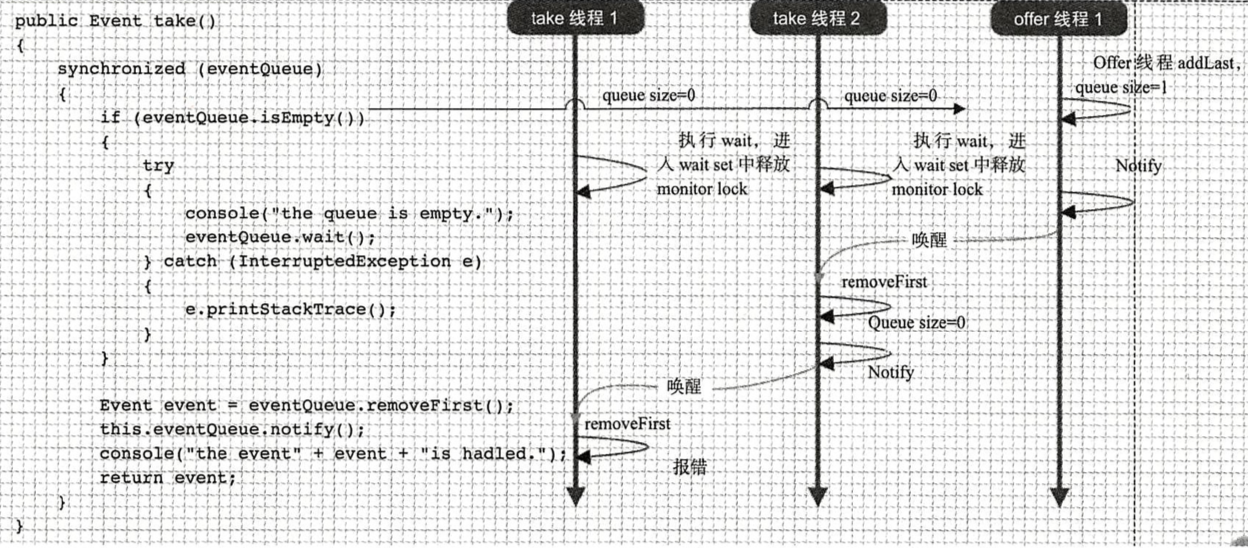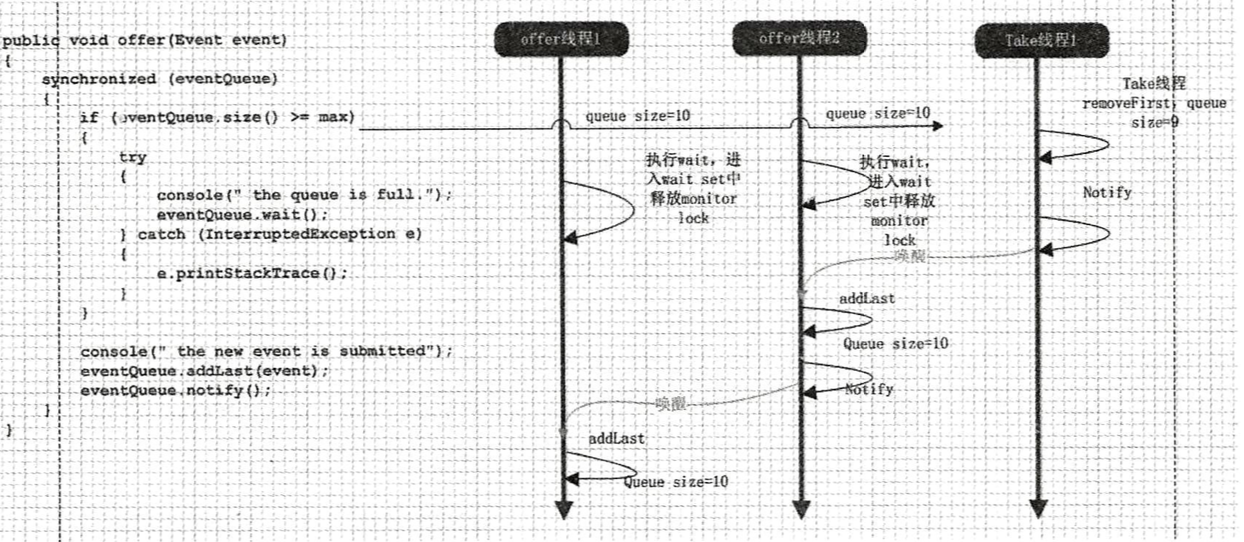Java 多线程学习笔记(二)基础
synchronized 关键字
synchronized关键字可修饰方法或代码块,被修饰的部分,对于多线程来说将按照同步方式来执行。
- synchronized 提供一种锁机制,能确保共享变量互斥访问,从而防止数据不一致问题。
- synchronized 关键字包括monitor enter 和 monitor exit 两个jvm指令,保证任何线程执行到monitor enter之前都必须从主存中获取数据,而不是从缓存中,monitor exit之后,共享变量被更新后的值必须刷入到主内存中。
- synchronized 严格遵守java happen-before 原则,一个monitor exit之前必须要有一个monitor exit
synchronized 修饰同步方法
1 | public synchronized void sync() { |
synchronized 修饰同步代码块
1 | private final Object MUTEX = new Object(); |
线程需要获得MUTEX对象相关联的monitor锁,才能执行同步代码块。未获得monitor锁的线程,将会处于blocked状态。
synchronized注意点
- 与monitor关联对象不能为空
- synchronized作用域不应太大
- 各个线程争取的monitor关联对象应该是同一个
- 小心死锁
This Monitor 和 Class Monitor
同步代码块可以手动设定需要关联锁的MUTEX对象。那么,同步方法呢?
同步方法争抢的是This Monitor的关联锁,this是指的该类实例对象。
故,同一对象的不同同步实例方法,以及synchronized(this)都是互斥的。
同步静态方法,争抢的是该类的class实例对象所关联的锁。因而不同同步静态代码也是互斥的。
wait 和 notify
wait和notify方法,是Object中的方法,意味着所有java对象都有着两个方法。调用某个对象的wait方法,可使执行线程进入等待。而调用某个对象的notify方法,可使因为调用该对象的wait方法进入等待的线程唤醒。
wait方法有三个重载方法。
1 | public final void wait() throws InterruptedException |
- wait这三个方法最终都调用到wait(long),wait()等价于wait(0)意味着用不超时,后两个会设置超时时间。超时时间指在该时间内未被唤醒,将会触发超时。
- 调用wait方法,必须先拥有该对象的关联锁,也就是说在该对象非同步代码块中调用wait方法会抛出异常。
- 当前线程执行了该对象的wait方法后,会放弃该对象的monitor锁并进入与该对象相关的wait set中,意味着其他线程有机会继续争抢该monitor的所有权。
notify方法
1 | public final native void notify() |
- 唤醒单个正在执行该对象wait方法的线程。
- 如果没有这样的线程,忽略该操作。
- 被唤醒的线程需要重新获取该对象所关联的monitor锁才能继续执行。
关于wait和notify的注意事项
- wait方法是可中断方法,其他线程interrupt是可以将其打断的。
- 线程执行某个对象的wait方法会进入与之对应的wait set中。每个对象的monitor都有一个与之对应的wait set
- wait和notify都必须在该对象的同步代码中使用,否则会报IllegalMonitorStateException,同步代码的monitor和与执行wait notify方法的对象一致,简单地说用哪个对象的monitor进行同步,就只能用哪个对象进行wait和notify操作。
示例代码
1 | public class EventQueue { |
1 | package org.chenghao.concurrent; |
多线程通信
上述示例代码,在多线程会出现问题。原因在于consumer和producer都是由同一个对象阻塞,producer并不能指定唤醒consumer,相反很可能唤醒一个producer。同样的情况对consumer也是存在的。


修改方法,将if->while,notify->notifyAll
1 | public void offer(Event event) { |
ThreadGroup
java程序中,任何一个线程,都会属于一个ThreadGroup中,默认情况下,新创建的线程会被加入到main线程所在的ThreadGroup中。
创建ThreadsGroup语法如下:1
2public ThreadGroup(String name)
public ThreadGroup(ThreadGroup parent, String name)
若是不指定其父group,则默认是创建线程所在的ThreadGroup。
ThreadGroup提供复制Threads功能1
2public int enumerate(Thread[] list)
public int enumerate(Thread[] list, boolean recurse)
enumerate(list)默认调用enumerate(list,true),会迭代复制。
类似的也有复制整个ThreadGroup数组1
2public int enumerate(ThreadGroup[] list)
public int enumerate(Thread[] list, boolean recurse)
效果类似。
守护ThreadGroup,将ThreadGroup设置为daemon,并不会影响其内部的线程daemon属性。当ThreadGroup的daemon设置为true后,那么当该group中没有任何active线程的时候,group将自动destroy。
线程运行时异常
UncaughtExceptionHandler
线程的执行单元是不能抛出checked异常的,可以使用UncaughtExceptionHandler接口来获取线程运行时异常信息,当线程运行出现异常是,将会回调该方法。1
2
3
4
public interface UncaughtExceptionHandler {
void uncaughtException(Thread t, Throwable e);
}
该方法会被Thread中的dispatchUncaughtException方法调用。1
2
3
4
5
6
7
8
9
10
11
12
13
14
15
16
17
18
19
20
21
22public class CaptureThreadException {
public static void main(String[] args) {
Thread.setDefaultUncaughtExceptionHandler(
(t, e) -> {
System.out.println(t.getName() + " occur exception");
e.printStackTrace();
}
);
final Thread thread = new Thread(
() -> {
try {
TimeUnit.SECONDS.sleep(2);
} catch (InterruptedException e) {
e.printStackTrace();
}
System.out.println(1/0);
}, "Test-Thread"
);
thread.start();
}
}

如果Thread未注入UncaughtExceptionHandler,将会返回group。group也是一个该接口的实现类,默认情况下,会寻找父group的Handler,如果没有父group,则寻找全局默认Handler,都没有,则输出到err中。
钩子线程
可通过Runtime.getRuntime().addShutdownHook(Thread t)来注入钩子线程,当jvm退出时,线程被执行。可以注入多个线程,均会被启动。钩子线程可以用来在jvm退出时,清除锁等操作。
注意钩子线程只有在收到退出信号时才会执行,比如ctrl+c或者kill。
但是kill -9不行。